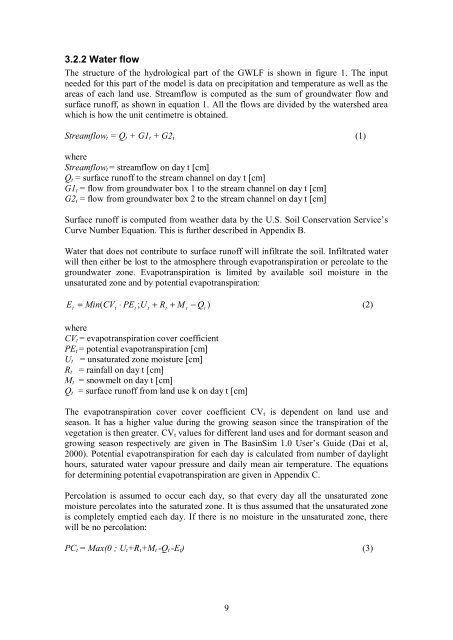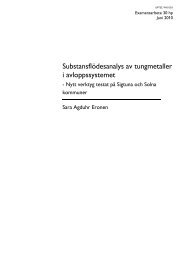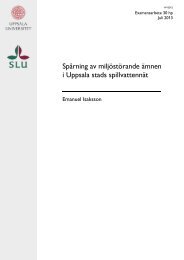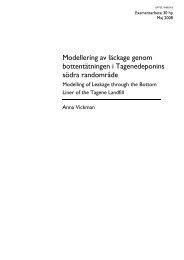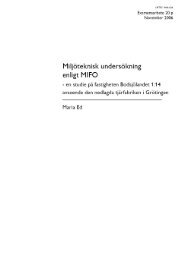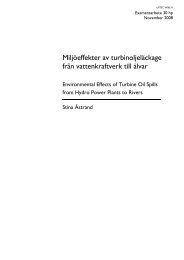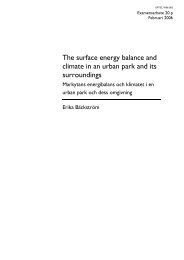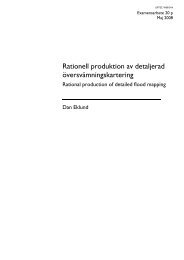Nutrient Transport Modelling in the Daugava River Basin - DiVA Portal
Nutrient Transport Modelling in the Daugava River Basin - DiVA Portal
Nutrient Transport Modelling in the Daugava River Basin - DiVA Portal
You also want an ePaper? Increase the reach of your titles
YUMPU automatically turns print PDFs into web optimized ePapers that Google loves.
3.2.2 Water flowThe structure of <strong>the</strong> hydrological part of <strong>the</strong> GWLF is shown <strong>in</strong> figure 1. The <strong>in</strong>putneeded for this part of <strong>the</strong> model is data on precipitation and temperature as well as <strong>the</strong>areas of each land use. Streamflow is computed as <strong>the</strong> sum of groundwater flow andsurface runoff, as shown <strong>in</strong> equation 1. All <strong>the</strong> flows are divided by <strong>the</strong> watershed areawhich is how <strong>the</strong> unit centimetre is obta<strong>in</strong>ed.Streamflow t = Q t + G1 t + G2 t (1)whereStreamflow t = streamflow on day t [cm]Q t = surface runoff to <strong>the</strong> stream channel on day t [cm]G1 t = flow from groundwater box 1 to <strong>the</strong> stream channel on day t [cm]G2 t = flow from groundwater box 2 to <strong>the</strong> stream channel on day t [cm]Surface runoff is computed from wea<strong>the</strong>r data by <strong>the</strong> U.S. Soil Conservation Service’sCurve Number Equation. This is fur<strong>the</strong>r described <strong>in</strong> Appendix B.Water that does not contribute to surface runoff will <strong>in</strong>filtrate <strong>the</strong> soil. Infiltrated waterwill <strong>the</strong>n ei<strong>the</strong>r be lost to <strong>the</strong> atmosphere through evapotranspiration or percolate to <strong>the</strong>groundwater zone. Evapotranspiration is limited by available soil moisture <strong>in</strong> <strong>the</strong>unsaturated zone and by potential evapotranspiration:Et= M<strong>in</strong> CV ⋅ PE ; U + R + M − Q )(2)(t t t t t twhereCV t = evapotranspiration cover coefficientPE t = potential evapotranspiration [cm]U t = unsaturated zone moisture [cm]R t = ra<strong>in</strong>fall on day t [cm]M t = snowmelt on day t [cm]= surface runoff from land use k on day t [cm]Q tThe evapotranspiration cover cover coefficient CV t is dependent on land use andseason. It has a higher value dur<strong>in</strong>g <strong>the</strong> grow<strong>in</strong>g season s<strong>in</strong>ce <strong>the</strong> transpiration of <strong>the</strong>vegetation is <strong>the</strong>n greater. CV t values for different land uses and for dormant season andgrow<strong>in</strong>g season respectively are given <strong>in</strong> The Bas<strong>in</strong>Sim 1.0 User’s Guide (Dai et al,2000). Potential evapotranspiration for each day is calculated from number of daylighthours, saturated water vapour pressure and daily mean air temperature. The equationsfor determ<strong>in</strong><strong>in</strong>g potential evapotranspiration are given <strong>in</strong> Appendix C.Percolation is assumed to occur each day, so that every day all <strong>the</strong> unsaturated zonemoisture percolates <strong>in</strong>to <strong>the</strong> saturated zone. It is thus assumed that <strong>the</strong> unsaturated zoneis completely emptied each day. If <strong>the</strong>re is no moisture <strong>in</strong> <strong>the</strong> unsaturated zone, <strong>the</strong>rewill be no percolation:PC t = Max(0 ; U t +R t +M t Q t E t ) (3)9


